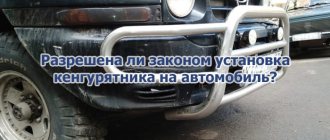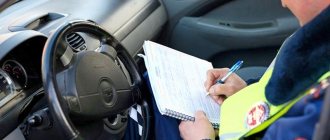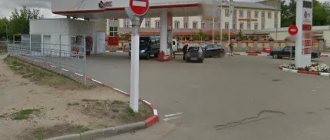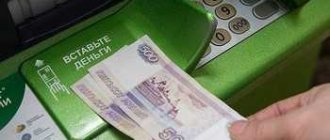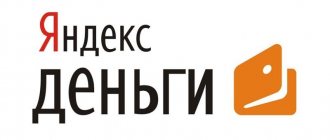Where are the cameras located? Official traffic police card
Yes, there is such a map in 2021. Under the auspices of crime prevention, instead of detection, the traffic police has released and maintains up-to-date an official map where you can see within the region and city where auto registration complexes are located.
The disadvantage of such a traffic police map is that it shows only stationary video cameras. Obviously, the portable tools will not be updated daily. But you won’t find these on other resources either - here only radar detectors can help.
View a map of traffic cameras in Russia on the official website of the State Traffic Safety Inspectorate.
To view the location of cameras, select your region in the drop-down list below the map and enlarge the map itself to find the road you need.
What types of fixation are there?
Most often, traffic police fines come from cameras when violations are recorded on stationary cameras. These are installed on poles and other supporting structures at the sides of transport arteries and monitor roads around the clock.
Different complexes have different technical characteristics, “farsightedness,” maximum fixation speed and a list of types of violations that they are ready to track.
In addition to them, portable video recording systems are used that “read” only speeding. Along with them, mobile traffic police cameras can also be used - in 2021 they will be installed on patrol cars and public transport. They see not only violations of the speed limit, but also non-compliance with parking rules, passage of heavy equipment and a number of other traffic violations.
And in some regions, the police have even begun to use drones and balloons, but this is more of an experiment than a rule. Let's take a closer look at the main video recording systems.
Radar in a traffic police car
To confirm your violation, the inspector must show a video recording or at least a filmstrip.
Otherwise, the inspector will not have any conclusive evidence of the driver’s guilt, and the decision can easily be overturned in court. To confirm your violation, the inspector must show a video recording or at least a filmstrip. Otherwise, the inspector will not have any conclusive evidence of the driver’s guilt, and the decision can easily be overturned in court.
In addition, traffic police now actively use mobile video recording systems, which are installed in the interior of a company car. In some versions, a radar with a camera and a computer (where the information is written) are located inside the car. In others, the radar is installed on the side of the road (in the bushes), and after some distance there is a traffic police car, where information about the offender is transmitted wirelessly. In the latter case, the traffic police inspector, having received the signal, will immediately stop the hurrying driver and issue a fine.
It is clear that with the advent of modern means of recording speed violations, the number of unfounded accusations should also decrease. After all, it will become more difficult for dishonest inspectors to falsify data. And if so, then it will be easier for us, drivers, to defend our rights and seek justice.
Hand-held radars - banned or not?
New cameras 2021
Let's start with the latest and simply new video recording systems that were installed on Russian roads not so long ago. Below we will show you how to find them on the map.
Hummingbird
This is one of the newest video recording systems, which is being actively installed in 2021 on Russian roads. On the map you can find them so far mainly in Moscow and Kazan, but they are also spreading in other cities.
The main advantage of the complex is its size, thanks to which they can be installed easily and in different places. Drivers often don’t notice them and therefore don’t slow down.
You will also be interested in:
- Traffic police cameras in Largus - how legal are they and what violations are they caught for?
- Can traffic police patrol in a civilian or private car, stop and fine?
- We drove under the camera at a yellow traffic light: will there be a fine and how to appeal?
Avtodoriya
This is a hardware and software complex that measures the speed of cars not using radars, but by mathematical calculations of the time it takes a recorded car to cover the distance between several recorders.
The system provides zonal speed control on road sections ranging from 250 meters to 10 km, and therefore it does not matter to the driver what distance he is from the recorder.
That is why there is no point in slowing down when passing Avtodoriya - it calculates the average speed in the section between two cameras.
Avtodoriya, in addition to speed, controls:
- intersection of dividing strips,
- detects violations of parking and stopping rules,
- records driving on the side of the road or in the public transport lane and other violations.
In addition, these traffic police cameras transmit online up-to-date information about the current traffic congestion. In 2021, you can find them on maps of Moscow, St. Petersburg, Kazan, Volgograd, Krasnodar and a number of others - mainly on highways near large cities.
You can see how Avtodoria records violations in the manufacturer’s official video.
Time-tested complexes
Strelka-CT
Perhaps the most common traffic police video camera on Russian roads is the Strelka ST. She can do the following:
- sees speed limit violators,
- controls traffic in the oncoming lane,
- on the side of the road,
- dedicated lane for public transport,
- crossing the stop line,
- movement of trucks in prohibited places and other violations.
The “vision range” of the camera exceeds 500 m. At this distance, it “catches” the violator in the traffic, “leads” him until he approaches a distance of 50 m, after which he records the violator and his license plate number using a camera. The downside of this system is that it does not respond to objects moving at speeds exceeding 180 km/h.
AvtoUragan-VSM2
This is not just a camera - it is a whole system that combines several photo-video recording complexes, which has a common time synchronization based on a signal from GLONASS/GPS. These traffic police cameras can record 17 types of traffic violations, including:
- over speed,
- driving on red,
- leaving the stop line,
- driving under a prohibiting sign,
- riding on tram tracks,
- sidewalks and bike paths.
The cameras see up to 4 road lanes, record objects at speeds of up to 255 km/h and provide accuracy with an error of no more than 2 km/h.
Odysseus
Autonomous stationary complex consisting of several cameras. It has 12 types of violations that it can capture, including:
- over speed,
- passing a prohibitory signal,
- driving into the oncoming lane,
- turning left or making a U-turn in violation of the markings,
- driving in the opposite direction on a one-way road, and so on.
The camera was created by TCOBDD LLC and reacts to objects moving at speeds of up to 250 km/h. The estimated error is ±1 km/h, the range of operation is classified by the manufacturer. In addition to recording traffic rules, the complex checks license plates for their presence in databases, for example, on the wanted list.
Krechet-SM, SKAT, SKAT-RIF, SKAT-PP
A series of cameras produced by Olvia LLC. Each of them has exceptional specific features. For example, KRECHET-SM provides continuous control with photo recording of all vehicles, SKAT can be used as a stationary or mobile fixing complex, SKAT-RIF works on the same principle as Avtodoriya, providing a mathematical calculation of the speed of movement.
And SKAT-PP is a traffic police camera designed to “catch” traffic violations in the pedestrian crossing area.
Krechet sees intruders in the range of 10-100 m, SKAT in the range of 5-50 m, and for SKAT-RIF such a range does not matter at all. Any of the systems recognizes violators if they move within 250 km/h.
Something else useful for you:
- Is it possible not to pay traffic fines and how?
- Is it possible to order and legally drive without a fine with license plates without the Russian flag?
- The traffic police inspector saw/filmed the violation, but didn’t stop it – what will happen?
Parkon-S
This complex is designed primarily to identify violators of stopping and parking rules. Parkon-S includes several PTZ street cameras controlled from a single center. Today you can find these funds on the maps of most Russian cities.
The system records cars parked in a given area and sends information about them to a single center: two photos with the date and time, license plate number, location and other information. Sees violators both on his own and on the opposite side of the road.
VOCORD Traffic
The VOCORD Traffic system is capable of recording 15 types of violations, including:
- speed limit violation;
- violation of intersection crossing rules;
- intersection of solid lines;
- violation of parking and stopping rules;
- violation in the pedestrian crossing area, etc.
The complex can include various components and measure speed using both detectors (up to 300 km/h) and optics (up to 250 km/h). The developers claim that the system is not recognized by radar detectors, provides 97% reliability of license plate recognition and passes less than 2% of total traffic.
What is the OSKON radar?
APK "OSKON" "S" (modifications "SM" or "RM") is designed for automatic recording of traffic violations by vehicle drivers. The radar is capable of detecting and recording the following offenses:
- Over speed;
- Violations when traveling through railway crossings;
- Violation of the rules for driving in lanes, oncoming traffic and overtaking;
- Failure to comply with highway traffic rules;
- Driving through a prohibiting traffic light or traffic controller;
- Violation of stopping and parking rules;
- Failure to comply with road signs and markings;
- Failure to give priority to pedestrians;
- Failure to provide priority in traffic to route vehicles and special vehicles with flashing lights turned on;
- Failure to comply with the rules for transporting large and heavy cargo.
That is, for example, if in the working area of the radar the driver does not have time to change lanes to a continuous line and drives one wheel onto it, then Oskon will record the violation and send a protocol with a receipt for payment of the fine to the car owner by mail. You can check for unpaid fines by following the link: Checking traffic police fines.
What prevents many modern radar detectors from catching a signal from Oskon in advance? But the fact is that this complex can be equipped with two types of radar units:
- Domestic, operating at a frequency of 24.150 GHz,
- Imported - with a frequency of 24.0 GHz.
This is the main problem. All our police radars operate in the frequency range from 24.150 GHz, so many low-power radar detectors, let’s say, cannot “digest” the lower frequency of 24.0 GHz.
In addition, the signal from Oskon has a very short pulse, which further complicates its detection. This speed meter will pay for itself in full until motorists massively update their “radar detectors.”
The speed measurement distance of the OSKON-SM radar reaches 160 meters (according to the passport data). This is the distance from which the camera's optics are able to detect and record a vehicle's license plate number.
Today, not all radar detectors work reliably using OSCON. And those “radar detectors”, the presence of which allows you to feel relatively safe, are in the middle and premium price categories (costing from 10 to 50 thousand rubles).
Mobile and mobile cameras
In addition to stationary ones, the traffic police use cameras in mobile and portable systems. Their use has not become so widespread, since the key condition for their use is control by employees. And the point is not even in ensuring their functionality, but in the fact that such cameras can simply be stolen from the side of the road. The most common such systems are:
- KRIS-P is a mobile photo radar complex that mainly “catches” speeding with the ability to transmit results via a radio channel of data and frames to a remote mobile post;
- ARENA is a mobile system for auto-photo recording of traffic violations, detecting violators on a controlled section of the road, measuring their speed, photographing the violator and transmitting the results to a remote computer via a radio channel;
- AMATA is a laser radar with a wide range of speed measurements from 1.5 to 280 km/h. The minimum distance for measurements is 15 m. It is controlled by traffic police officers using a remote control and provides targeted sampling from the traffic flow.
How to protect yourself from traffic police radar ARENA
Speedcam for Navitel
The Russian soul cannot come to terms with the fact that someone constantly wants to punish it for its desire to drive fast. Each radar operates at a specific frequency. The signal can be distinguished using a radar detector, which is installed inside the vehicle and is designed to recognize the photo radar signal. Having caught the radiation from the detector, it promptly warns the driver about the danger, thereby prompting the driver to reduce the speed to the set value.
| https://youtube.com/watch?v=mooT-__M0b8 |
A good anti-ARENA radar can combine other functions, including video recording, GPS navigator, etc. The driver, depending on the speed of travel, will have a few seconds to reduce the fine or avoid punishment completely. If you don’t know how to protect yourself from the ARENA radar, then be sure to purchase a radar detector for yourself. It's no secret that this type of detector is picked up (caught) by most modern radar detectors, both budget and sophisticated expensive ones. The only problem is that ARENA works not only in the front, but also in the back. Those. The speed is measured as the vehicle moves away from the camera.
Types of traffic police radars (traffic police, traffic police) ARENA
Today, there are two main types of ARENA photo radars: mobile and stationary. Both the first and second options are designed to record speed violations. However, the ARENA mobile complex can be installed at the edge of the road and put into operation in just a few minutes. As a rule, employees of the state automobile inspection use it to identify violators on the most “interesting” sections of the road.
Another thing is a stationary radar detector, the ARENA radar, which is used on certain sections of the route for a long time. It is installed on poles or structures out of the driver’s field of vision, and it is quite difficult to notice it from afar. In addition, such a traffic police detector complex (DPS) has a constant power source, which ensures its uninterrupted operation. The radar detector allows you to protect the driver from both the first and second types of radar, reliably protecting the driver from unnecessary fines.
Main technical characteristics
| Speed measurement range, km/h | from 20 to 250 |
| Speed measurement error, km/h | no more than 2 |
| Size of one frame with violation, Kb | no more than 200 |
| Archive volume on flash card 1Gb, files | not less than 5000 |
| Availability of a built-in function for automatic recognition of GRZ | There is |
| Number of traffic lanes for which automatic recognition of GRZ is provided | 3 |
| Availability of a built-in function for automatic rejection of frames with questionable evidence | There is |
| Operating distance of the radio channel (in line of sight conditions and in the absence of industrial interference) | up to 1.5 km |
| Availability of data protection with digital signatures | There is |
| Compatibility of data generated by the complex with software systems | There is |
| Time of continuous operation of the control line from a fully charged battery, hours, not less | 8 |
Innovations from the traffic police: quadcopters and balloons
Not long ago, traffic police officers took it further - now in their arsenal they also have flying cameras placed on drones and balloons. Their use was first tested back in 2021, but they are not in permanent service until now in 2021.
Of course, they are not so “smart” and cannot independently determine the presence of a traffic violation and transmit information about this to a single center. However, they may well play the role of the “remote eyes” of the inspector and record offenses using a camera. The main thing is that it is an official traffic police camera, which has passed a meteorological check and was certified in accordance with GOST R 57145.
Of course, copters and balloons will not be able to determine the speed of the car. But the location of stationary traffic police cameras is not possible in all places, which cannot be said about the use of aerial equipment. In addition, they can be used without problems in places where there is a significant concentration of cars and help identify violations such as:
- intersection of double solid;
- driving into the oncoming lane;
- violation of travel rules at unregulated pedestrian crossings;
- driving to the side of the road, sidewalk, bike path;
- violation of overtaking rules and so on.
In the meantime, the operation of such means of fixation is not automated, the main thing is that the aircraft are reliable and do not fall on the roofs of cars or the heads of pedestrians!

